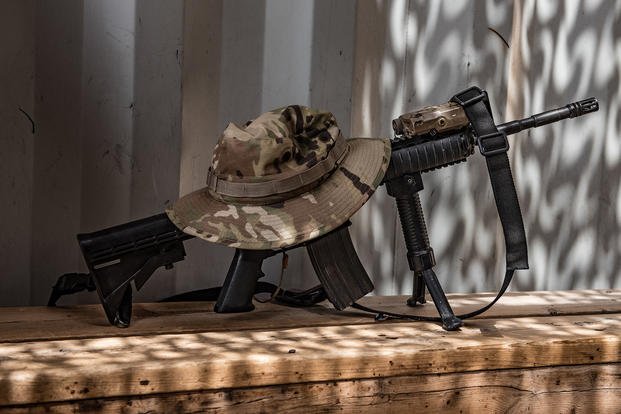

The necks of airmen at Nellis Air Force Base, Nevada, will continue to scorch under the blistering summer sun after a request to let them don the military’s iconic boonie hat was denied by higher headquarters.
Col. Joshua DeMotts, commander of the 99th Air Base Wing at Nellis, wrote to Air Combat Command boss Gen. Kenneth Wilsbach last month with a plea for cool heads: Could airmen wear the floppy Operational Camouflage Pattern boonie hats instead of ball caps during the hot weather months from April 1 to Nov. 1?
“Due to the extreme heat at Nellis AFB that tops 120 degrees during the summer, it is imperative to adjust aspects of the uniform to ensure appropriate protection is afforded to our airmen performing their duties,” DeMotts wrote in the memo. “The boonie hat will allow the relief of excess body heat and protection for the neck and face from the intense summer sun.”
Wilsbach’s response put the request on ice: No.
DeMotts’ memo, signed July 9, appeared on the unofficial “Air Force amn/nco/snco” Facebook page on Thursday. Air Combat Command spokesperson Lt. Col. Emily Grabowski confirmed the document’s authenticity on Friday.
She declined to provide a reason why the commander denied Nellis’ request.
“Local commanders may request exceptions to policy outside of current Department of the Air Force instruction, and it is within the ACC commander’s authority to approve or disapprove,” Grabowski said.
In the hours after the memo leaked online, airmen took to social media to blast the answer as an example of out-of-touch leadership.
“@aircombatcommand what is going on,” Instagram user @mudhen_memes, an account dedicated to the F-15E Strike Eagle fighter, asked Thursday. “Can you step out of the way and let us execute the mission you’re asking??”
Boonie hats are round, wide-brimmed sun hats worn by troops in particularly hot or tropical climates, such as the jungles of Vietnam, that call for more-breathable headgear with greater skin coverage than a ball cap to prevent burns and cancer. Air Force regulations allow deployed airmen, and those authorized by a major command such as Air Combat Command, to wear the OCP boonie hat “when theater conditions dictate.”
For some service members, the hats constitute peak military fashion; for others, they’re an unprofessional, confusing accessory. The latter outlook has landed them on the off-limits clothing list for most troops for years.
But not all senior officers keep floppy headgear at arm’s length. Last October, the commander of Fort Bliss authorized the wear of boonie caps for soldiers at the El Paso, Texas, installation, which averages nearly 300 days of sun each year. They remain banned on other Army bases.
Wilsbach’s decision to deny Nellis airmen their boonie hats comes on the heels of his command-wide push to reinforce dress and appearance standards that he believes have slipped.
In June, Wilsbach told airmen under his purview they had a month to undergo unit-level inspections to ensure all adhere to Air Force regulations on uniforms, grooming, customs and courtesies. He also directed wings to check whether troops’ personnel records are in compliance with medical and religious exemptions — to see, for instance, whether an airman with a beard possesses a shaving waiver.
The directive applies to Air Combat Command’s more than 157,000 uniformed and civilian employees who supply fighter jets, intelligence-collection aircraft, cyber operators and more to U.S. forces in North America, South America, the Middle East and Southwest Asia. It sparked a scramble to find well-fitting uniforms at base exchanges and thrift shops, as well as plenty of grumbling on social media.
Wilsbach argues that holding airmen to the standards in place is key to their military identity and operational prowess as the U.S. prepares for a possible war with China in the Pacific. When troops pay attention to the small details, he said in July, they’ll get the hard parts right as well.
The deadline to finish the inspections was July 17.
Related: Boonie Caps Permitted for Soldiers at Fort Bliss But Remain Unauthorized for Rest of Army Bases
